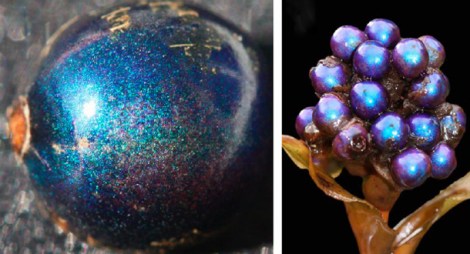Pollia condensata looks like it’s wearing holographic nail polish, but it’s a real living fruit that grows that way — in fact, it’s the shiniest living thing in the world.
The principle behind P. condensata‘s gorgeous finish is basically the same as behind an iridescent beetle’s wings. The cells in the fruit’s husk contain layers of fibers that run parallel to one another, with each layer turned slightly relative to the one beneath it (like this). Each layer reflects some of the light that hits it, and the spiral structure makes the reflected light waves line up so that they intensify each other. The wavelength of the light may be different from cell to cell, but all of them reflect extra-intensified light. Result: a mixture of really, really bright colors.
This type of iridescent coloration was supposed to be reserved for insect wings and bird feathers — P. condensata is the first time it’s been seen in a plant. But damned if it doesn’t blow the rest of them out of the water. The fruits reflect more light (i.e. are shinier) than any other known living thing. You’re pretty? They’re prettier.
In terms of taste and nutrition, you’d be better off buying some Sally Hansen and painting your blueberries with it — P. condensata is all flash and no juice or pulp. The eye-catching colors are there to fool birds into thinking that if other nearby berries are bright blue, but not as bright, then they must be tasty, but not as tasty. Which works, because they’re birds and birds are suckers. But so what if the fruits are bright and shiny and gorgeous and have no substance? So’s Carly Rae Jepsen, and have you stopped singing her song even once this summer? You have not.




